
Icerya purchasi is a scale insect that feeds on more than 80 families of woody plants, most notably on Citrus and Pittosporum. Originally described in 1878 from specimens collected in New Zealand as pests of kangaroo acacia and named by W.M. Maskell "after the Rev. Dr. Purchas who, [he] believe[d], first found it". It is now found worldwide where citrus crops are grown. The cottony cushion scale originates from Australia.

William Miles Maskell was a New Zealand farmer, politician and entomologist.

Albert Koebele was an economic entomologist and a pioneer in the use of biological controls to manage insect pests.

Coccinellidae is a widespread family of small beetles ranging in size from 0.8 to 18 mm (0.03–0.7 in). They are commonly known as ladybugs in North America and ladybirds in Great Britain. Some entomologists prefer the names ladybird beetles or lady beetles as they are not true bugs. Many of the species have conspicuous aposematic colours and patterns, such as red with black spots, that warn potential predators that they are distasteful.

Coccinella transversalis, commonly known as the transverse ladybird or transverse lady beetle is a species of ladybird beetle found from India across southern and southeastern Asia to Malesia and Australia. It is not to be confused with Coccinella transversoguttata, a widespread species in Europe and North America also known as the transverse ladybird. The alternative vernacular of small transverse ladybird may be used for C. transversalis in instances where these two species are discussed together.

Cryptolaemus montrouzieri, common name mealybug ladybird or mealybug destroyer, is a ladybird species.
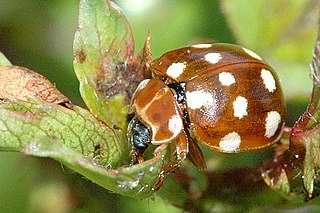
Calvia quatuordecimguttata, the cream-spot ladybird, is a species of ladybird in the family Coccinellidae. Its distribution is holarctic, it being found in Europe and through the East Palearctic to Japan. It is introduced to North America. This ladybird is generally 4 to 5 millimetres in length and varies in appearance depending on the geographical location. It usually lives in hedgerows and deciduous trees.
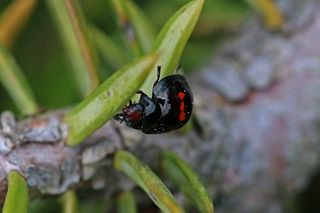
Chilocorus bipustulatus, the heather ladybird, is a beetle species belonging to the family Coccinellidae, subfamily Chilocorinae.
Dorcadion pusillum is a species of longhorn beetle of the subfamily Lamiinae.
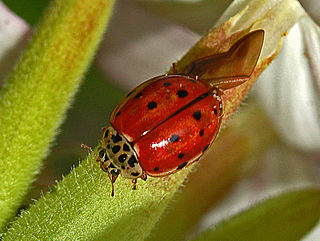
Harmonia quadripunctata, the cream-streaked lady beetle or four-spot ladybird, is a species of ladybird belonging to the family Coccinellidae.

Stenurella bifasciata is a species of beetle in the family Cerambycidae.
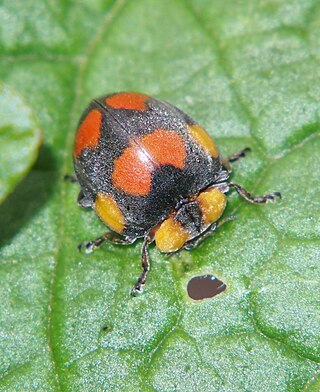
Papuaepilachna guttatopustulata, the large leaf-eating ladybird, is a species of ladybird, formerly in the genus Henosepilachna endemic to parts of Australasia, specifically New South Wales, Queensland, the Bismarck Archipelago, New Guinea, New Hebrides and Solomon Islands.

Charles Pugsley Lounsbury was an American-born South African entomologist, widely regarded as having laid the foundations of economic entomology in Southern Africa.
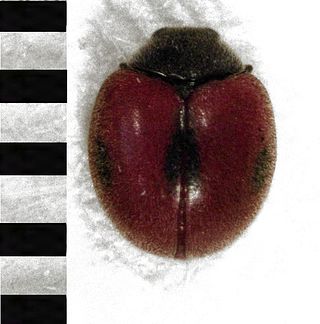
Novius koebelei is a species of ladybird beetle native to Australia. It is also present in the wild in New Zealand, where it is of exotic origin. In New Zealand, it was first reported in 2006, having been found in Auckland. It has been known under many names; due to variation in its colouration, it has been described as new six times after its original description in 1892.

Novius is a genus of ladybird beetles belonging to the family Coccinellidae, and the sole member of the tribe Noviini. The genus as presently defined contains over 70 species, most of which were formerly placed in the genera Rodolia and Anovia, but after decades of debate, both of these genera are now considered to be junior synonyms of Novius.
Henosepilachna vigintioctomaculata is a species of beetle in the family Coccinellidae. It is commonly known as the 28-spotted potato ladybird, a name also used for the closely related species, Henosepilachna vigintioctopunctata.

Frazer Smith Crawford was a photographer in the colony of South Australia, founding manager of the Adelaide Photographic Company, then photolithographer for the South Australian government. In a seemingly unrelated sphere, Crawford came to be recognised as an authority on agricultural pests and diseases, particularly known for identifying and exploiting naturally occurring predators of plant pests.

Novius iceryae is a species of ladybird beetle native to Afrotropical realm, and was described from South Africa. It is also found in Senegal. In 1880, Novius iceryae was used to successfully control cottony cushion scale, Icerya purchasi in South Africa. It was later introduced in New Zealand for the management of cottony cushion scale. This and related species were formerly classified in the genus Rodolia.

Cyclotoma cingalensis, is a species of handsome fungus beetle found in Sri Lanka.
Novius octoguttata is a species of lady beetle native to India, Sri Lanka, Pakistan, Myanmar and China.



















